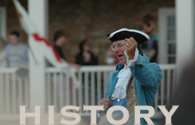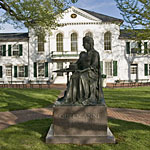 Centreville Centreville
Named for its central and easily accessible
location, Centreville, incorporated in 1794,
is the seat of Queen Anne’s County. Pre-Civil War
and Victorian era styles decorate
the town with vivid history. St. Paul’s Church,
with communion silver circa 1717, The Tucker House, and
Wright’s Chance are all notable examples of 18th
century architecture. The courthouse located on the central
green, is the oldest courthouse in continuous use in the
State of Maryland since 1791.
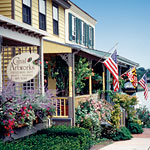 Chesapeake City Chesapeake City
Step back in time with a visit to Historic
Chesapeake City. A wonderful collection
of distinct 19th century historic homes and shops, beautifully restored along the Chesapeake
and Delaware Canal. Antiquing, collectibles, clothing,
and crafts are among the shopper delights in Chesapeake
City as well as art galleries, summer concerts, boat
tours on the
canal, and tours of nearby horse country.
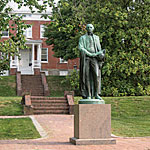 Chestertown Chestertown
Chestertown has been a Royal Port of Entry, the scene
of its own Revolutionary Tea Party (1774), and the hub
of a thriving agricultural and seafood area. Kent County’s
original courthouse (c.1697), the Geddes-Piper House,
Emmanuel Church, Fountain Park, the Charles Sumner G.A.R.
Hall and numerous 18th century structures makes a walk
around Chestertown a stroll back in time. Visit the
Kent County Visitor Center for a copy of the Walking
Tour of
Historic Chestertown guide.
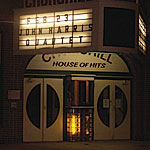 Church Hill Church Hill
The town of Church Hill grew out of a
1698 water mill, the foundations of which
can be seen along Route 19. St. Luke’s
Church (c. 1732) is located on the hill, from
which the town derives it’s name. The Church Hill
Theatre, built in 1929 as a movie theatre was saved
from demolition in the 1980’s and now regularly
holds theatrical productions.
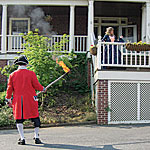 Kitty Knight House Kitty Knight House
During the War of 1812, the British fleet
wreaked havoc in Chesapeake Country.
Coming ashore in George-town and Fredericktown along
the Sassafras River, the British set fire to the houses.
Catherine (Kitty) Knight used her charm on the soldiers
to prevent them from burning her house and the adjacent
home. These historic homes today are now joined to
form a historic bed and breakfast overlooking the Sassafras
Harbor.
|
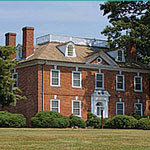 Mount Harmon
Plantation Mount Harmon
Plantation
During the 17th and 18th centuries, Mount Harmon pros-pered as a tobacco plantation.
As visitors drive the 2-mile lane, you will
appreciate the isolation of the time when
trans- portation moved most freely by water.
Mount Harmon boasts the northernmost existing tobacco
prize house. “Prize” refers to the huge wooden
screw used to compress tobacco from two casks or “hogsheads”
into one. The restored Plantation home (c.1730) also
offers
boxwood gardens, nature trails and is open for seasonal
tours for an admission fee.
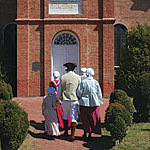 Old Bohemia Old Bohemia
St. Francis Xavier Church is a church
steeped in history, religious beliefs and
tradition. Since 1704, the Catholic tradition
has been lived, celebrated and cherished here. It was
one of the earliest Catholic establishments in the English
Colonies. The churchyard is noteworthy for the burial
sites for several founding fathers of the Catholic faith
and that of Kitty Knight, a local heroine of the War
of 1812.
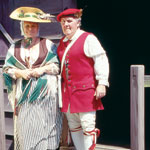 Queenstown Queenstown
Also known as “Parvus Urbs Ad Is Aqua”
(Little Town On The Water) Historic
Queens- town was the first county seat and is home to
Queen Anne’s County original colonial courthouse(c.1708). During the Battle of Slippery Hill, Queens-town
was the first and only town in Queen Anne’s County
to be attacked by the British during the War of 1812.
Today, agriculture and seafood harvesting are dominant
economic industries.
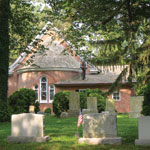 St. Paul’s of Kent St. Paul’s of Kent
St. Paul’s of Kent is the earliest surviving
religious structure in Kent County. It is
one of only four 18th century structures on
the Eastern Shore to have a semi-circular apse. The
Flemish bond brickwork, modillions in the cornice, and
other architectural features are exceedingly rare features
for this region and are considered extraordinarily fine
for the period. The extensive churchyard covers 19 acres
and
harbors numerous tree species as well as historic gravestones.
The oldest stone is circa 1727. More modern graves include
that of Hollywood actress Tallulah Bankhead.
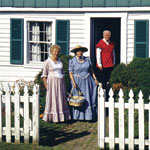 Stevensville Stevensville
Lovers of 19th century history and architecture will
find Stevensville a lovely
stop on the byway. Examples include:
Christ Church, (c. 1880) is a lovely example of Gothic
architecture; The Old Stevensville Post Office (c. 1870)
served the community until 1952 and is now home to the
Kent Island Heritage Society; The Cray House (c. 1809)
is a rare example of post and plank construction. The
Walking Tour of Historic Stevensville guide will lead
you to all 23 stops in this historic district.
|



